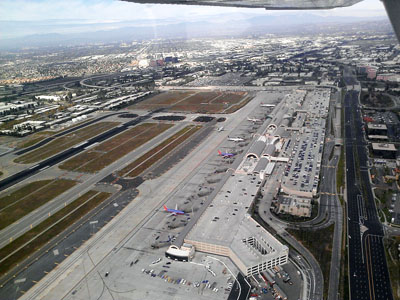 The number of passengers and flights at John Wayne Airport would gradually increase starting in seven years under a noise agreement proposed Thursday by the city of Newport Beach and local airport-noise groups. The early morning and late night curfew on operations would remain in effect until 2035.
The number of passengers and flights at John Wayne Airport would gradually increase starting in seven years under a noise agreement proposed Thursday by the city of Newport Beach and local airport-noise groups. The early morning and late night curfew on operations would remain in effect until 2035.
Thursday’s announcement marked the beginning of a process to modify and extend the existing airport-noise agreement that is due to expire in 2015.
Newport Beach Mayor Keith Curry said the proposal struck a balance between the needs of the communities surrounding the airport and federal law, which restricts the local limits that can be placed on airports.“This maintains the status quo through 2020,” he said.
After 2020, the airport could gradually increase passenger levels from the 10.8 million allowed now to a maximum of 12.5 million in 2026. Ten more flights using large-passenger jets could be added to the current 85 daily flights, but the airport would still bar airline takeoffs before 7 a.m. and landings after 11 p.m.
Officials at the airport, which is owned by the county, did not take an official position since the agreement is subject to hearings and an environmental review.
“For nearly 30 years the county has demonstrated its commitment to the settlement agreement and achieving a balance between quality-of-life concerns of residents in the vicinity of the airport, the needs of the air traveling and shipping public, and the desire of the aviation industry to provide air service to Orange County,” said a statement from John Wayne Airport.
The Airport Working Group and Stop Polluting Our Newport, the two community groups that joined Newport Beach in 1982 to sue the county over airport noise, participated in the 18 months of negotiations with the county. They were all parties to the court settlement in 1985 that established the current noise limits and must sign off on any modifications.
Curry said he believed the plan would win the support of the community during the public review process, which will begin Tuesday when the Newport Beach City Council gets the official memorandum of understanding detailing the changes.
The county Board of Supervisors will consider the memorandum on April 16. The memorandum is the first step before the county initiates an
environmental review.
Supervisor Todd Spitzer, who represents Orange, North Tustin, Tustin and other foothill communities in the airport’s landing pattern, said those residents will have a full opportunity to express any concerns and issues about the proposal during the environmental review process.
The Federal Aviation Administration must also sign off on the plan. Participants to the negotiations said the FAA had not raised any objections.
Not everyone fully supported the plan. AirFair, an airport-noise group that was not part of the talks, released a statement saying it was grateful for the work done to keep the noise settlement agreement in place but that the current 10.8 million cap on passengers should be retained.
“It remains the AirFair position that 10.8 million annual passengers is our ‘fair share,'” the group said.
Leonard Kranser, a South County resident who fought the El Toro Airport, said he was glad Newport Beach residents would not be subjected to
late-night airport noise or jet pollution. But he questioned why flights and passengers needed to be so strictly limited when a new terminal opened in 2011.
“The number of (large-jet passenger) flights was set at 85 beginning Jan. 1, 2003, and now will be held at that number for 17 years through 2020 despite the construction of the new third terminal,” he said.
The noise agreement does not address a possible extension of John Wayne’s runway. That is the subject of a separate 2006 agreement that says Newport Beach must approve any acquisition of land that would be used to expand the runway or add a second commercial runway.
JWA noise limit proposal
Curfew hours: Current limits would be retained through 2035. No commercial departures are allowed before 7 a.m. Monday-Saturday or 8 a.m. Sunday; no arrivals after 11 p.m.
Passenger limits: The current cap of 10.8 million annual passengers would increase to 11.8 million from 2021-25. Up to 12.5 million passengers would be allowed beginning in 2026, depending on demand in the previous five years.
Flight limits: The current cap of 85 daily departures by the loudest commercial passenger jets will remain in effect through 2020. The cap would rise to 95 departures in 2021. Cargo flights would remain limited to four a day.
